- Jerome Powell’s testimony at the US Congress. It will be a high -level event that will move the market this week.
- New clues are expected on the path of interest rates of the Federal Reserve.
- The US dollar, stock markets and other asset classes could experience large oscillations with the words of the president of the Fed.
Jerome Powell, president of the United States Federal Reserve (USA) (FED), will present the semiannual monetary policy report and testify to the Financial Services Committee of the US House of Representatives. UU. UU. Tuesday. The audience will begin at 14:00 GMT and will have the total attention of all actors in the financial market.
Jerome Powell is expected to address the main prominent points of the Fed monetary policy semiannual report, published last Friday. In that report, the Fed said that there are some early signals that suggest that tariffs are promoting inflation and reiterated that monetary policy is well positioned for what is to come.
In a long session of questions and answers, the members of the Chamber are expected to ask Powell about the path of interest rates, the developments of inflation and economic perspectives. It is also very likely that they inquire about how the policies of the US president, Donald Trump, and the current geopolitical environment could influence prices, growth prospects and monetary policy in the future.
Related news
-
Fed: I’m open to cutting interest rates as soon as in July – Michelle Bowman
-
Jerome Powell testimony: a crucial encounter between the Federal Reserve and political power
CMM’s Fedwatch tool shows that the markets are currently valuing in approximately 20% the probability that the Fed lowers the policy rate in 25 basic points (PBS) in July, after maintaining their status quo at each meeting this year. The revised summary of Economic Projections (SEP), published together with the policy statement after the June meeting, showed that those responsible for policies still project two cuts of 25 basic points (PBS) in 2025 and a single cut in 2026, compared to two cuts of rates marked in the SEP of March.
In an interview with CNBC last Friday, the governor of the Fed, Christopher Waller, said the Fed is in a position to lower the rates as soon as in July. Citing worrying signals in the labor market, such as a high unemployment rate between newly graduated and a slower job creation, Waller argued that Fed should not wait for the labor market to collapse before relaxing politics. Similarly, the governor of the Fed, Michelle Bowman, said she would be in favor of lowering the interest rate in the next meeting to align the policy more closely with her neutral configuration and maintain a healthy labor market.
In case Powell indicates that they will not have enough data to confirm a rate cut in July and reiterate that they need to remain patient, market positioning suggests that the US dollar (USD) could gain strength against their rivals in the immediate reaction. On the contrary, a significant sale of the USD could be seen if Powell leaves the door open for a policy relaxation step in July. Comments on inflation perspectives, especially with the increase in energy prices due to growing geopolitical tensions in the Middle East, could also promote the valuation of the USD.
About Jerome Powell (Vía Federalreve.gov)
“Jerome H. Powell first assumed the position of President of the Board of Governors of the Federal Reserve System on February 5, 2018, for a period of four years. He was re -elected for the position and took possession of a second four -year term on May 23, 2022. Mr. Powell also serves as president of the Federal Open Market Committee, the main body of formulation of monetary policies of the system. Powell has been a member of the Board of Governors since he assumed the position on May 25, 2012, to complete a mandate not expired.
Fed Faqs
The monetary policy of the United States is directed by the Federal Reserve (FED). The Fed has two mandates: to achieve prices stability and promote full employment. Its main tool to achieve these objectives is to adjust interest rates. When prices rise too quickly and inflation exceeds the objective of 2% set by the Federal Reserve, it rises interest rates, increasing the costs of loans throughout the economy. This translates into a strengthening of the US dollar (USD), since it makes the United States a more attractive place for international investors to place their money. When inflation falls below 2% or the unemployment rate is too high, the Federal Reserve can lower interest rates to foster indebtedness, which weighs on the green ticket.
The Federal Reserve (FED) celebrates eight meetings per year, in which the Federal Open Market Committee (FOMC) evaluates the economic situation and makes monetary policy decisions. The FOMC is made up of twelve officials of the Federal Reserve: the seven members of the Council of Governors, the president of the Bank of the Federal Reserve of New York and four of the eleven presidents of the regional banks of the Reserve, who exercise their positions for a year in a rotary form.
In extreme situations, the Federal Reserve can resort to a policy called Quantitative Easing (QE). The QE is the process by which the Fed substantially increases the flow of credit in a stuck financial system. It is a non -standard policy measure used during crises or when inflation is extremely low. It was the weapon chosen by the Fed during the great financial crisis of 2008. It is that the Fed prints more dollars and uses them to buy high quality bonds of financial institutions. The one usually weakens the US dollar.
The quantitative hardening (QT) is the inverse process to the QE, for which the Federal Reserve stops buying bonds from financial institutions and does not reinvote the capital of the bonds that it has in portfolio that they expire, to buy new bonds. It is usually positive for the value of the US dollar.
Source: Fx Street
I am Joshua Winder, a senior-level journalist and editor at World Stock Market. I specialize in covering news related to the stock market and economic trends. With more than 8 years of experience in this field, I have become an expert in financial reporting.







